Finding a Reverse Polarity Bootleg Ground with a Multimeter
A reader’s comment causes me to come up with new compound words to describe the different types of RV grounding…
Everyone
An article I posted back on May 2023 prompted a comment a few days ago about confusion on how to find an RPBG with a multimeter. And after reading the comment several times I realized that I needed to make up some new compound words to describe the various types of grounds occurring in an RV or house. So here’s the comment and my answer first, followed by the original article on Reverse Polarity Bootleg Grounds.
Hey Mike,
Am I overthinking this? But using a VOM with a RPBG, if I check for voltage from the hot side to ground, I would not see voltage when I should. And conversely, if I checked for voltage from the neutral to ground, I should not see voltage, but with RPBG, I would see voltage. Have I got ‘my’ wiring crossed ? At least this should trigger my noodle, that something is not correct. - Steve P
Dear Steve,
I think that clarifying the differences between Earth-Ground, Outlet-Ground and Chassis-Ground will help reduce confusion. The real problem is that the word “ground” is used for several different electrical grounding scenarios, two of which have nothing to do with the earth at all.
And no, putting a ground rod in a bucket of dirt is NOT a ground!!!
“Earth-Ground” is the dirt (earth) beneath your feet.
“Outlet-Ground” is the ground contact in a receptacle that should be connected to the shore power EGC. (Equipment Grounding Conductor)
“Chassis-Ground” is all the metal parts of your RV that are bonded together including the chassis, skin, hitch, bumpers, etc…
I’ll be making a video of this meter testing procedure in a few weeks
Measurements
An RPBG miswired outlet will measure close to zero volts between the Hot Leg and Earth-Ground .
An RPBG miswired outlet will measure around 120 volts between Neutral and Earth-Ground, plus 120 volts between Outlet-Ground and Earth-Ground.

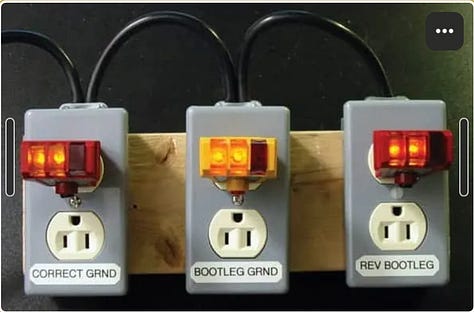

But most testing procedures use the Chassis-Ground or Outlet-Ground as the reference, which is why 3-light outlet testers, advanced outlet analyzers, and metering the outlet between H-N-G with a voltmeter will not be able to discover an RPBG. But measuring 120 volts between Earth-Ground and the Outlet-Ground is a good indicator of a Reverse Polarity Bootleg Ground.
Note: I use a screwdriver stuck in the damp dirt to creaete an Earth-Ground reference
RPBG Theory in Review…
Let’s review what an RPBG (Reverse Polarity Bootleg Ground) is and why it’s dangerous.
This is a dangerous miswiring condition that I discovered and named more thn 10 years ago, and it’s important to understand since an RPBG can sometimes be found in 1970s or earlier era houses, garages, performance stages, churches and campgrounds. If you plug your RV into an outlet miswired with an RPBG, then you’re creating a life-threatening condition.
What’s an RPBG?
But first here’s a picture of how and why this condition exists in the first place. If you look at the leftmost outlet above (Labeled Correct Ground), you’ll see that it’s wired correctly with a green/ground wire, white/neutral wire, and a black/hot wire. All houses, stages and campground outlets since the early 1970s are supposed to be wired like that. And probably 99.99% of them are wired correctly.
But if you’ve ever done any wiring in an old house, stage, boat dock or even campground, you’ll find that the green ground wires didn’t exist in the 1960s or before. That’s because the National Electrical Code didn’t require any kind of ground conductor at that point in time. So that’s when ungrounded, 2-prong, polarized outlets were installed everywhere..
Modern wiring
However, by the early ’70s the National Electrical Code changed and all new installations were required to install 3-prong grounded receptacles with 15- or 20-amp capacity. But since there were no preexisting ground wires already run in the walls, some electricians and DIY guys would do something called a “Bootleg Ground,” which you can see in the middle outlet of the next diagram. That is, they would simply jumper the ground screw on the back of the outlet over to the neutral wire.
While that’s a huge code violation, in many cases there’s no immediate danger, and many older installations still have upgraded grounded outlets with bootleg grounds. I’ll just note that this is a dangerous practice and any discovered bootleg ground outlets should be corrected by running new wiring that includes a ground conductor (formally called an EGC for Equipment Grounding Conductor). Note that it’s also possible to install a Class-A GFCI receptacle that’s not-grounded, and it will pass code. But it’s supposed to be marked as ungrounded.
However, if you do make a bootleg ground and also happen to get the Hot/Neutral polarity reversed at the same time, then you create something I call a Reverse Polarity Bootleg Ground, or RPBG for short. That’s shown in the rightmost outlet of the above diagram.. It’s probably the most dangerous kind of miswiring condition you’ll ever encounter since it does two things.
Why is an RPBG so dangerous?
First, an RPBG outlet will energize the skin, chassis, tow vehicle and virtually everything plugged into or connected to your RV with a 120 volts of hot-skin/contact-voltage, and with at least 20 amps of current behind it. But the RV and all its appliances will operate normally with no warning signs of an energized surface. So no sparks, no blue glow, no hum, and no other special effects you might see in the movies.
A 3-light tester can’t find an RPBG
And as you can see in the picture from my lab bench, a 3-light outlet tester will tell you the outlet is OK, when in fact the ground and chassis/skin of your RV is sitting at 120 volts of potential. There are simply no warning signs.
Standard meter tests won’t find an RPBG
Second, an RPBG is not discoverable by any standard meter test, 3-light outlet tester, or even the most expensive EMS surge protectors on the market. Note that if you measure H-G, G-N and H-N the voltages are exactly the same as a properly wired outlet. You have to measure against an external ground reference to find an RPBG with a voltmeter.
While Progressive initially told their customers that their products could detect and disconnect an RV from the hot ground voltage of an RPBG outlet, once I sent my schematics to their engineering department and had them build a test unit, they called me back to let me know I was correct. They never realized such a condition could exist in the wild, and their EMS surge protectors were helpless to warn you about the condition.
RPBG outlets in the wild
I’ve personally seen RPBG miswired outlets in at least a few dozen old campgrounds, boat docks, churches and sound stages. In fact, anytime I see a brand-new 3-prong grounded outlet in an old building, I’m doubly careful to test it for RPBG miswiring since electricians still take this inexpensive shortcut, even though it’s a big code violation.
A Non-Contact Voltage Tester can find an RPGB
The only simple way to detect an RPBG condition is by using a Non-Contact Voltage Tester (NCVT), which is a procedure I developed and pioneered for the RV industry. As you can see above, a NCVT will easily find an outlet that’s been miswired with a RPBG condition.
I’ve discussed this RPBG condition with every EMS/Surge-Protector manufacturer in the market and currently none of their products can detect or disconnect your RV from one. However, I’ve been working on a possible solution that would allow an EMS/surge-protector to alert you of this hot-chassis condition, no matter what the cause.
Watch this video on using an NCVT to find a hot-skin…
In the meantime, be sure to use your Non-Contact Voltage Tester every time you hook up to shore power to make sure the campground pedestal or garage outlet and your RV are safe from any hot-skin voltages. For those of you who don’t know what a Non-Contact Voltage Tester (NCVT) is or how to use one, watch my video below.
More on this later, but the important takeaway is to never ignore a shock when touching your RV. If you do feel a shock, unplug from shore power immediately until you can find the cause and repair it.
Let’s play safe out there… Mike




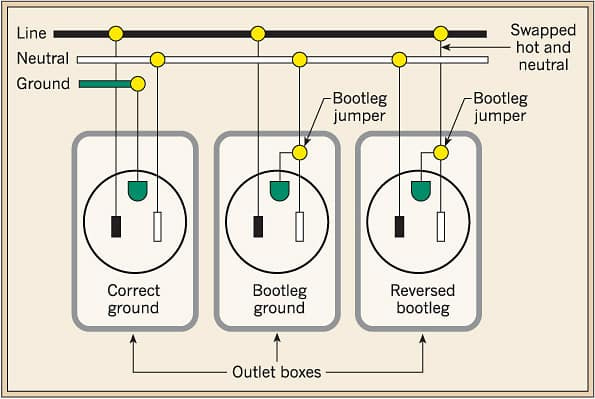

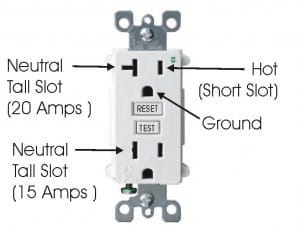
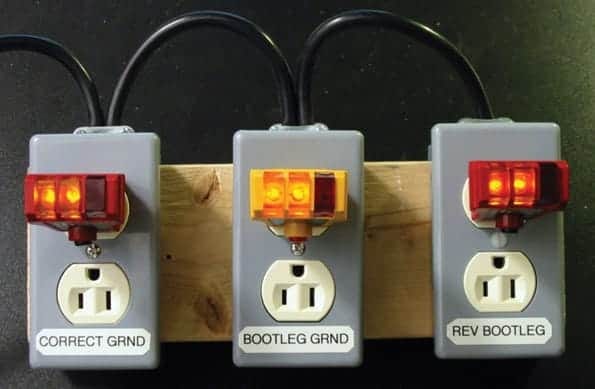
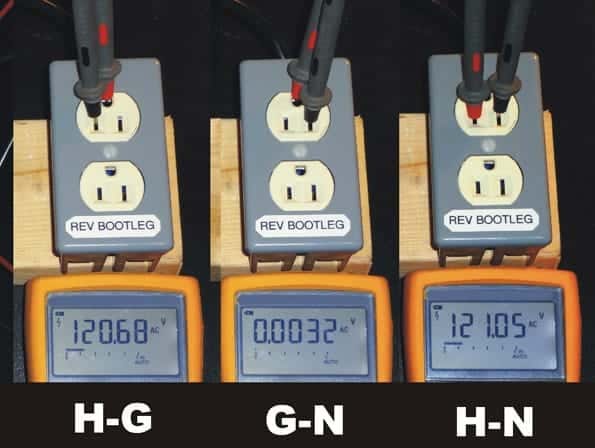
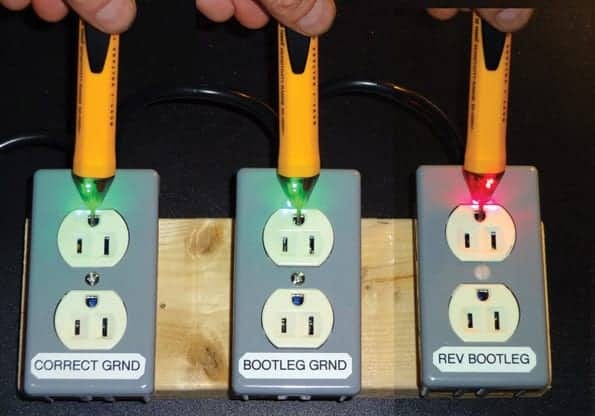


Mike: we generally stay at government run campgrounds - mostly state but some county. I have been assuming that they use union electricians and I don't worry about mis-wiring mistakes. Plus, these campsites are filled most weekends so any issues would have long ago been dealt with. Am I being stupid?